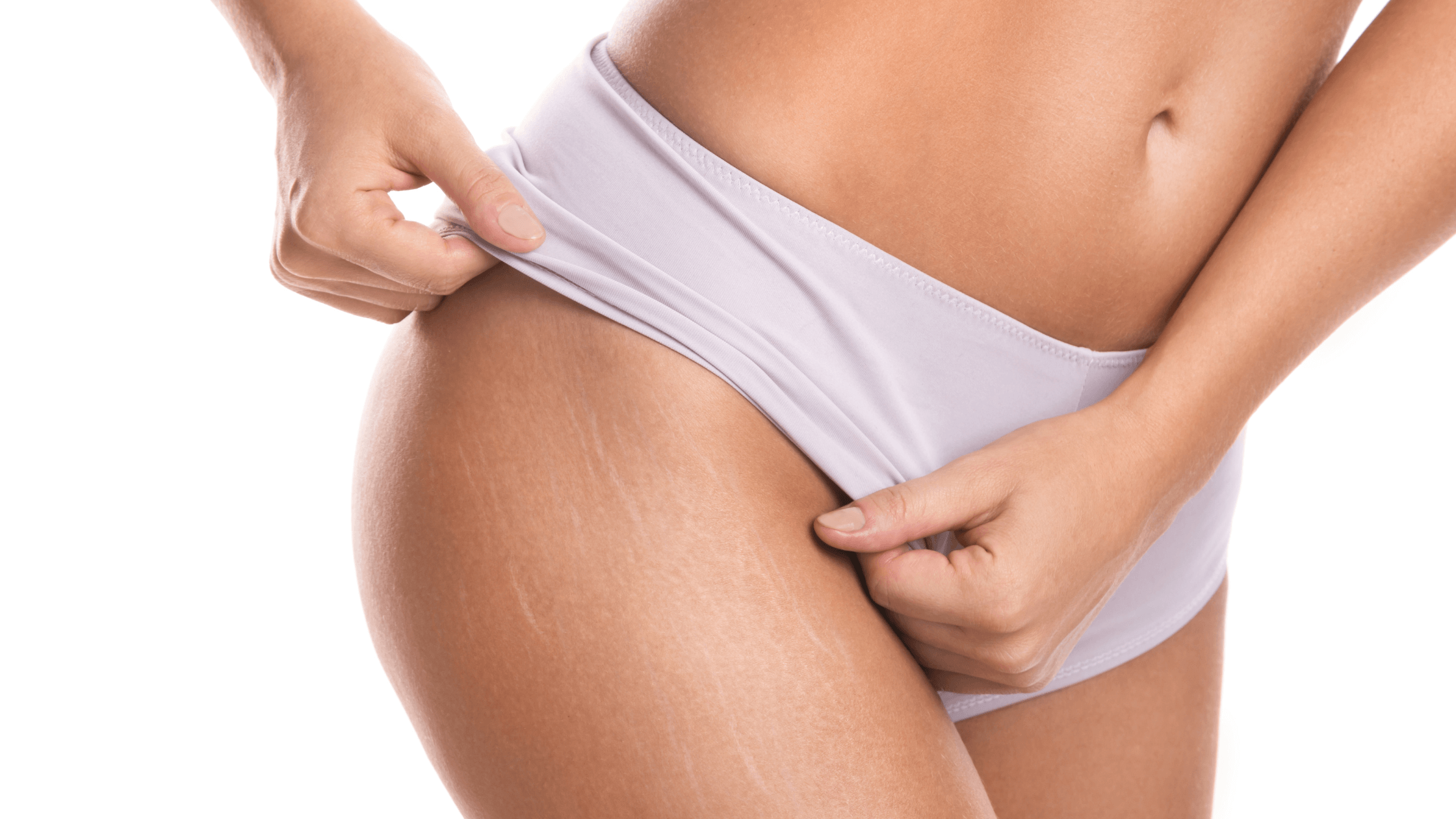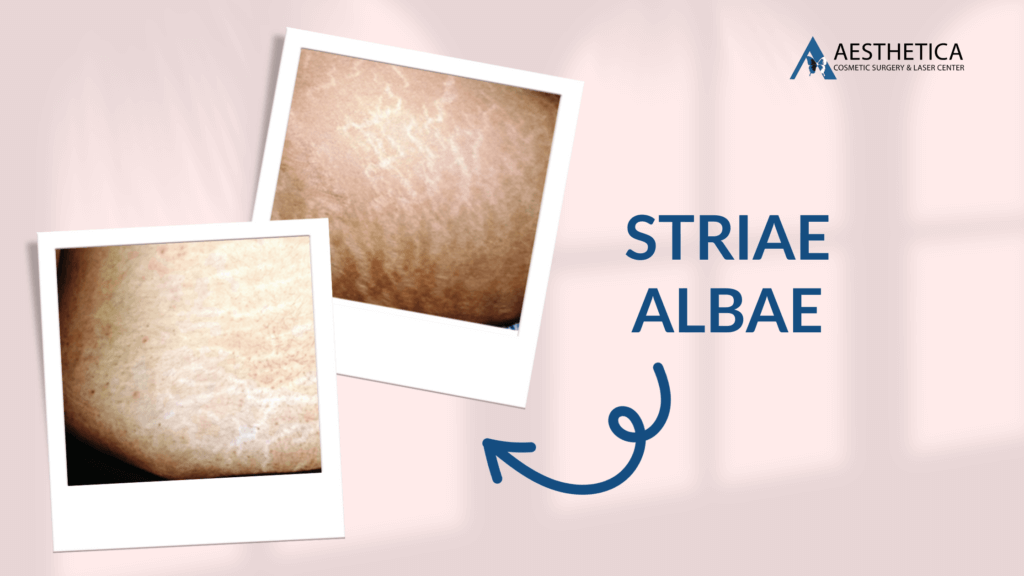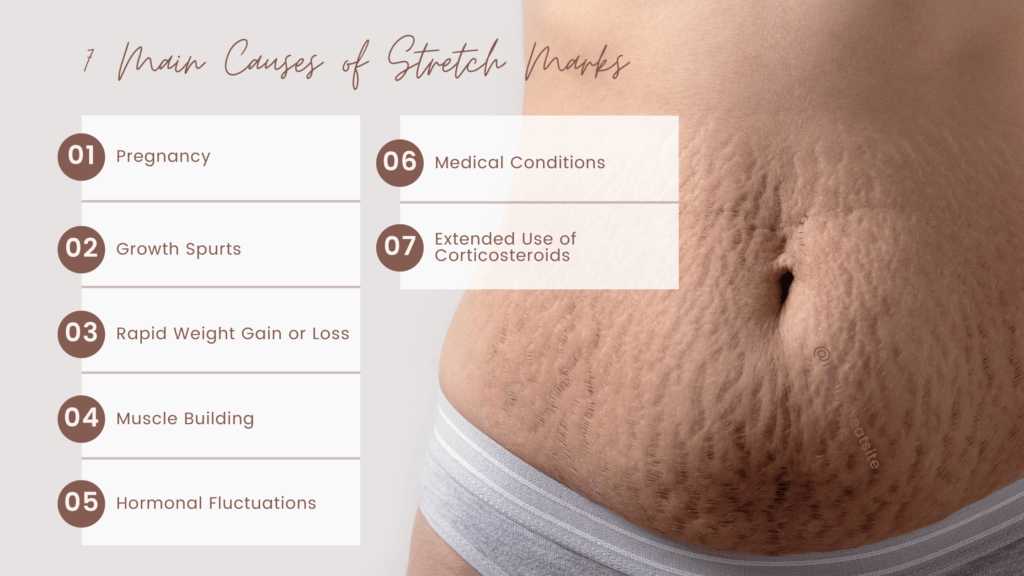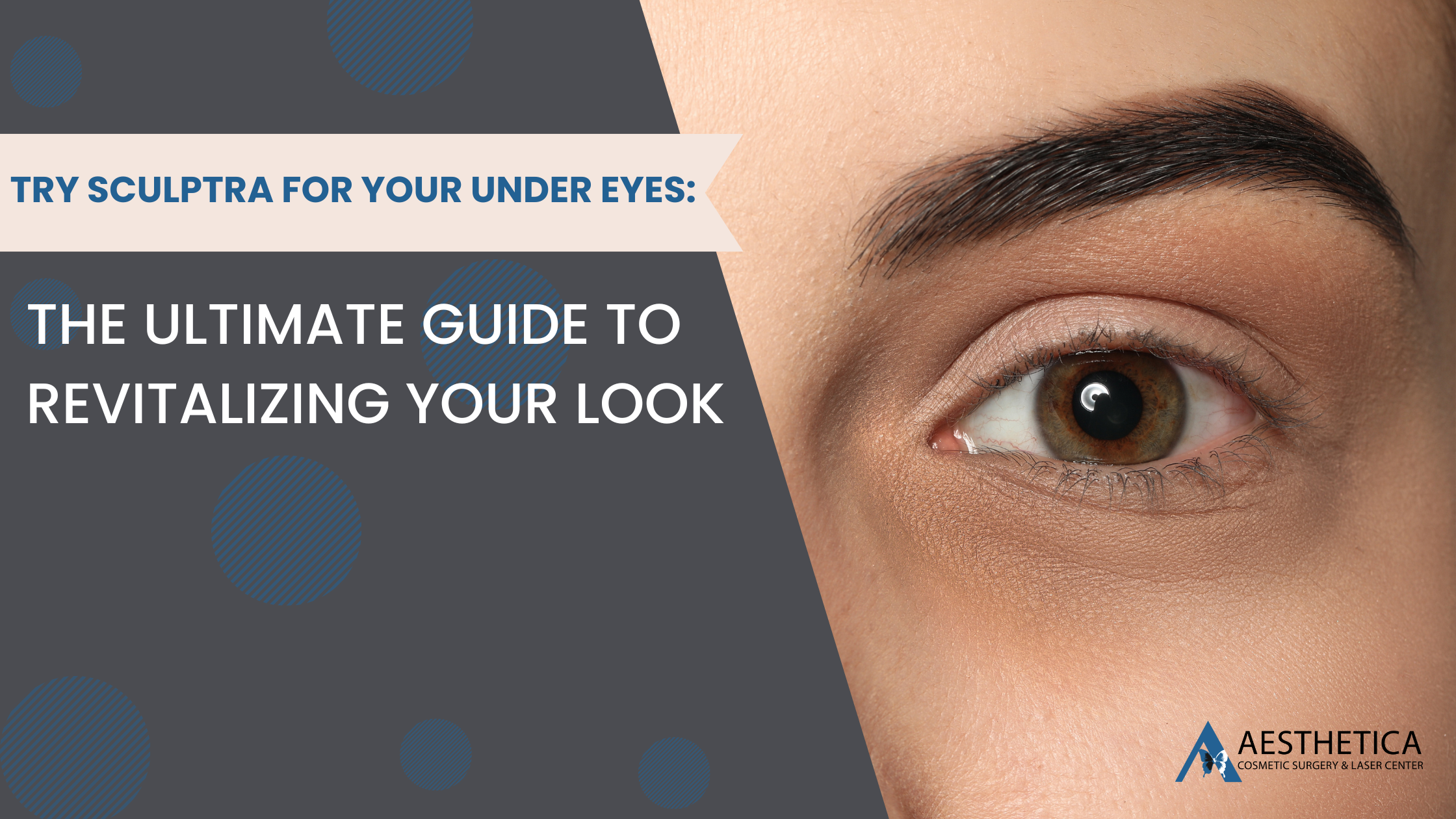
Aesthetica Editorial Team

Stretch marks affect men and women of various ages and backgrounds. These silver, reddish, or purple streaks appear on different body parts, often evoking feelings of self-consciousness.
But what exactly are stretch marks, and what causes them?
In this detailed guide, we will delve deep into the types and causes of stretch marks, shedding light on this common skin concern.
What are Stretch Marks?
Stretch marks are long, narrow stripes or streaks that develop on the skin’s surface when it gets stretched quickly. They typically appear on the abdomen, breasts, thighs, hips, buttocks, and arms. Fortunately, stretch marks tend to diminish over time.
3 Types of Stretch Marks
Striae Rubrae

When the skin first experiences rapid stretching, it often reacts by displaying red or purple linear scars known as striae rubrae. These marks signify the immediate response of the skin to sudden expansion.
Their vibrant color emerges because of the inflammation in the dermis, leading to the dilation of tiny blood vessels. These marks feel slightly raised to the touch and can sometimes be itchy or tender. Over time, striae rubrae evolve as the inflammation subsides and the body starts its natural healing process.
Striae Albae

The once-vividly colored striae rubrae gradually fade from a deep red or purple hue to a more subdued silvery-white shade. This transition marks the development of striae albae.
The skin’s texture in these areas can feel indented or depressed compared to the surrounding skin. Although the intensity of their color has faded, their visibility can still be prominent, especially on darker skin tones. The color change represents a decrease in blood vessel activity and skin thinning in the affected areas.
Striae Gravidarum

Pregnancy brings along numerous changes to a woman’s body. Among these changes, many women notice stretch marks called striae gravidarum.
These marks predominantly form around the abdominal region, where the skin experiences the most stretching to accommodate the growing fetus. Striae gravidarum can also appear on the breasts, hips, and thighs.
While the initial appearance of striae gravidarum may resemble striae rubrae, their association with pregnancy distinguishes them. The hormonal shifts, rapid weight gain, and the skin’s stretching during pregnancy create the perfect environment for these stretch marks to form.
As with other types, striae gravidarum can evolve, transitioning from a reddish hue to a more muted white or silver as the body recovers post-pregnancy.
7 Main Causes of Stretch Marks

Understanding the reasons behind the appearance of stretch marks will help in their prevention and treatment:
- Pregnancy: The skin expands rapidly during pregnancy, especially around the belly area, resulting in striae gravidarum.
- Growth Spurts: Adolescents may experience stretch marks during puberty as their bodies rapidly change.
- Rapid Weight Gain or Loss: Quick weight change may lead to skin stretching or shrinking, inducing the formation of stretch marks.
- Muscle Building: Intense physical activity that leads to muscle growth, such as bodybuilding, can stretch the skin enough to produce these marks.
- Hormonal Fluctuations: Hormones play a role in skin elasticity. Changes in hormonal levels, especially during puberty and pregnancy, influence the skin’s capacity to stretch and bounce back.
- Medical Conditions: Certain conditions, like Marfan syndrome and Cushing’s syndrome, cause stretch marks. In Marfan syndrome, the tissue’s ability to stretch is affected. In Cushing’s syndrome, the body produces too much of a hormone that leads to rapid weight gain and skin fragility.
- Extended Use of Corticosteroids: Prolonged corticosteroid creams and lotions reduce skin collagen levels, increasing the chances of stretch marks.
Stretch Mark Prevention and Management
Keeping the skin hydrated, maintaining a balanced diet, avoiding rapid weight fluctuations, and using creams and oils specially formulated to enhance skin elasticity are just a few of the ways you may reduce the appearance of stretch marks.
But DIY approaches are only the first step toward prevention and management.
At Aesthetica, we offer a variety of cosmetic treatments to make stretch marks a thing of the past!
PRP Therapy for Stretch Marks
Platelet-rich plasma (PRP) therapy has gained popularity as an innovative method to treat stretch marks.
The growth factors in PRP stimulate the skin cells, promoting collagen production and enhancing the skin’s overall healing capabilities. As a result, the appearance of stretch marks diminishes over time.
Here’s how it works:
- Extraction: We draw a small quantity of blood, similar to a routine blood test.
- Separation: We separate the blood components using a centrifuge, isolating the platelet-rich plasma.
- Reinjection: We reintroduce the PRP into the stretch mark areas using small injections.
Microdermabrasion for Stretch Marks
Microdermabrasion is another highly effective technique we use to treat stretch marks.
This non-invasive procedure exfoliates the top layer of the skin using tiny crystals or a diamond-tipped wand.
Here’s an insight into the process:
- Exfoliation: We run a specialized tool over the stretch marks that releases fine crystals. These crystals gently exfoliate the skin’s top layer, removing dead skin cells.
- Suction: Post exfoliation, a vacuum sucks away the crystals and the dead skin cells, leaving the skin rejuvenated.
- Stimulation: Removing the top layer stimulates the skin underneath to produce more collagen, boosting skin elasticity and reducing the appearance of stretch marks.
When to Consider PRP Therapy and Microdermabrasion for Your Stretch Marks
Deciding the best time to seek PRP therapy or microdermabrasion for stretch marks is crucial to achieving the desired results.
PRP Therapy: Timing It Right
- Early Appearance: Consider PRP therapy soon after noticing the formation of stretch marks, especially when they are still in the striae rubrae phase. The red or purple hue indicates active inflammation and blood vessel dilation. That’s when PRP actively promotes collagen regeneration and enhances skin healing.
- Post-Pregnancy: Once the body starts to recover and hormones stabilize, PRP can be an excellent option to rejuvenate the skin and diminish the appearance of striae gravidarum.
- Chronic Stretch Marks: Even if your stretch marks have transitioned to striae albae, don’t lose hope. PRP therapy improves skin texture and appearance, making these marks less prominent.
Microdermabrasion: When to Dive In
- Surface Level Concerns: Microdermabrasion excels at treating the skin’s top layer.
- Maintenance Mode: If you’ve already undergone other stretch mark treatments and want to maintain or further improve your skin’s appearance, microdermabrasion is an excellent supplementary procedure.
- Prevention is Key: Regular microdermabrasion sessions enhance skin elasticity, potentially reducing the risk of developing new stretch marks, especially during anticipated skin stretching like pregnancy or muscle building.

Unlock Healthier, Revitalized Skin Today!
Whether you’re addressing fresh stretch marks or longstanding scars, our expert team is here to guide and support you every step of the way. Reclaim your skin’s beauty and confidence. Act now and schedule your personalized consultation to kickstart your journey to smoother, more radiant skin!
Meet us at 19500 Sandridge Way, Suite 350, Leesburg, VA 20176, or call us at (703) 574-4342 for a complimentary consultation with Board-Certified Plastic Surgeon Dr. Phillip Chang before proceeding with your procedure. If everything matches up, our team will help you navigate the entire process from beginning to end. Also, remember to check out our blog and social media for more information on cosmetic surgery trends!
Let Us Help You!
Our office can provide you with helpful information, schedule a free consultation, and walk you through the many services and procedures we provide.
Contact Dr. Chang's Office:
More Articles For You

Find Your Glow: 7 Reasons Why Aesthetica Is the Best Microneedling Provider in Leesburg, VA!
In the quest for vibrant, youthful skin, microneedling has emerged as a cornerstone treatment, beloved

Try Sculptra for Your Under Eyes: The Ultimate Guide to Revitalizing Your Look
In aesthetic enhancements, Sculptra has emerged as a revolutionary treatment, especially for addressing concerns about

The Latest Techniques in Double Chin Removal in Leesburg, VA
In the charming town of Leesburg, VA, where looking good and feeling great are top

The Art of Refining the Side Profile of a Woman through Plastic Surgery
In the realm of cosmetic enhancements, the side profile of a woman holds a pivotal
